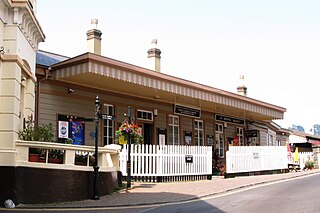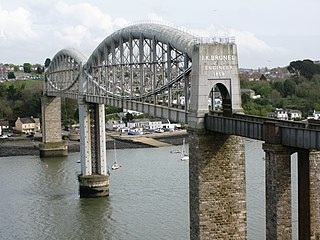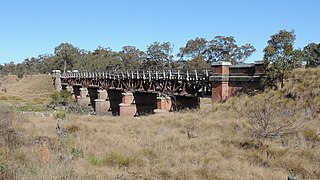
Port Adelaide station is a railway station located on the Outer Harbor line. Situated in the north-western Adelaide suburb of Alberton, it is 11.7 kilometres from Adelaide station.

The Dry Creek–Port Adelaide railway line is an eight-kilometre east–west frieght railway line running through Adelaide's north-western suburbs. The line is managed by the Australian Rail Track Corporation (ARTC) and is an important link between Port Adelaide, Pelican Point and the main interstate rail routes which link Adelaide with Melbourne, Perth, Darwin and Sydney. Prior to 1988, a limited local passenger service operated, stopping at five intermediate stations along the line. Since May 1988, the line has been freight-only.
The Kingston Branch was a major railway line in Southland, New Zealand. It formed part of New Zealand's national rail network for over a century: construction began in 1864, Kingston was reached in 1878, and it closed in 1979. For much of its life, it was considered a secondary main line rather than a branch line, and in its earlier years, it was sometimes known as the "Great Northern Railway". Today, the southern portion now forms a part of the Wairio Branch and the northernmost 14 kilometres was used by the Kingston Flyer.

The North Auckland Line is a major section of New Zealand's national rail network, and is made up of the following parts: the portion of track that runs northward from Westfield Junction to Newmarket Station; from there, westward to Waitakere; from there, northward to Otiria via Whangārei. The first section was opened in 1868 and the line was completed in 1925. The line, or sections of it, have been known at various times as the Kaipara Line, the Waikato-Kaipara Line, the Kaipara Branch and the North Auckland Main Trunk.

The Cornwall Railway was a 7 ft 1⁄4 in broad gauge railway from Plymouth in Devon to Falmouth in Cornwall, England, built in the second half of the nineteenth century. It was constantly beset with shortage of capital for the construction, and was eventually forced to sell its line to the dominant Great Western Railway.
The Western Line, previously known as the Launceston and Western Line, is a 223 km freight rail corridor that runs from Western Junction to Wiltshire in Tasmania, Australia.

Sydney, the largest city in Australia, has an extensive network of passenger and freight railways. The passenger system includes an extensive suburban railway network, operated by Sydney Trains, a metro network and a light rail network. A dedicated freight network also exists. Future expansion of the light rail network includes the Parramatta Light Rail. Existing light rail services are the Inner West Light Rail and the CBD & South East Light Rail.

The Otago Central Railway (OCR) or in later years Otago Central Branch Railway, now often referred to as the Taieri Gorge Railway, was a secondary railway line in Central Otago, in the South Island of New Zealand.

The Loughor railway viaduct carries the West Wales Line across the River Loughor. It is adjacent, and runs parallel to, the Loughor road bridge. The 1880 viaduct was granted Grade II listed building status. Before it was demolished in early 2013, the viaduct was the last remaining timber viaduct designed by Isambard Kingdom Brunel.

The South Devon and Tavistock Railway linked Plymouth with Tavistock in Devon; it opened in 1859. It was extended by the Launceston and South Devon Railway to Launceston, in Cornwall in 1865. It was a broad gauge line but from 1876 also carried the standard gauge trains of the London and South Western Railway between Lydford and Plymouth: a third rail was provided, making a mixed gauge. In 1892 the whole line was converted to standard gauge only.

The Dartmouth and Torbay Railway was a broad gauge railway linking the South Devon Railway branch at Torquay with Kingswear in Devon, England. It was operated from the outset by the South Devon Railway.
The Vale of Neath Railway (VoNR) was a broad gauge railway company, that built a line from Merthyr Tydfil and Aberdare to Neath, in Wales, chiefly to transport the products of the Merthyr iron industries to ports on Swansea Bay.

The Cornish Main Line is a railway line in Cornwall and Devon in the United Kingdom. It runs from Penzance to Plymouth, crossing from Cornwall into Devon over the famous Royal Albert Bridge at Saltash.

The Albion–Jacana line is a railway line in the western suburbs of Melbourne, Australia. Linking Albion on the Sunbury line to Jacana on the Craigieburn line, it is primarily used by freight trains and has no overhead wires, passenger stations or platforms.

Ian Barry Brickell was a New Zealand potter, writer, conservationist and founder of Driving Creek Railway.

The Natal Government Railways 2-6-0TDurban and Pietermaritzburg of 1877 were two South African steam locomotives from the pre-Union era in the Colony of Natal.
The Glen Massey Line was a private railway of 10.6 km near Ngāruawāhia in the Waikato region of New Zealand, built to serve coal mines, and, from 1935, run by the New Zealand Railways Department. The line had grades of 1 in 40, sharp curves - sharpest 6 ch and 40 of less than 10 ch - and 22 bridges, including a 91.5-metre-long and 18.3-metre-high timber trestle bridge over Firewood Creek halfway between Ngāruawāhia and Glen Massey and a 70-foot-long (21 m) bridge, adapted in 1917 to take sheep, on 52 ft (16 m) piles over the Waipā River, as well as the railway, after collapse of the road bridge.

The Tenterfield Creek railway bridge is a heritage-listed former railway bridge that carried the Main North line across the Tenterfield Creek from Sunnyside to Jennings, both in the Tenterfield Shire local government area of New South Wales, Australia. It was designed by John Whitton and Engineer-in-Chief for NSW Government Railways and built in 1888. The bridge is also known as the Sunnyside rail bridge over Tenterfield Creek. The property is owned by RailCorp, an agency of the Government of New South Wales and was added to the New South Wales State Heritage Register on 2 April 1999.
Loughor railway station was on the South Wales Railway, now the West Wales Line, from Swansea to Llanelli. The station was located on the west side of Swansea in the residential area of Loughor.

The Belmont Viaduct was a railway viaduct in Paparangi, New Zealand. The viaduct was originally built by the Wellington and Manawatu Railway Company as part of the Wellington-Manawatu line. When opened in 1885, with its original kauri wood structure, it was the largest of its kind in New Zealand. At the time it was reputed to be the largest wooden viaduct in the world, however this claim was largely disputed.


















